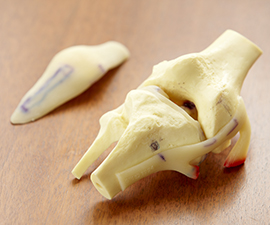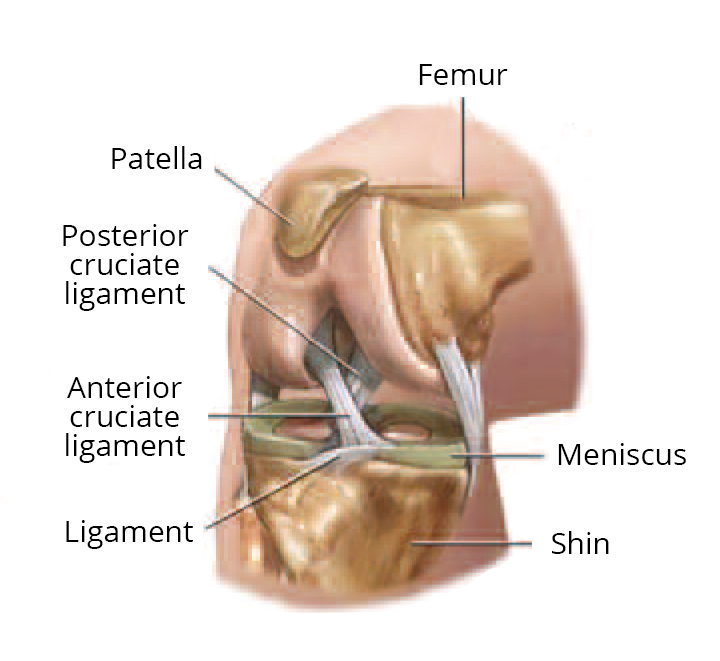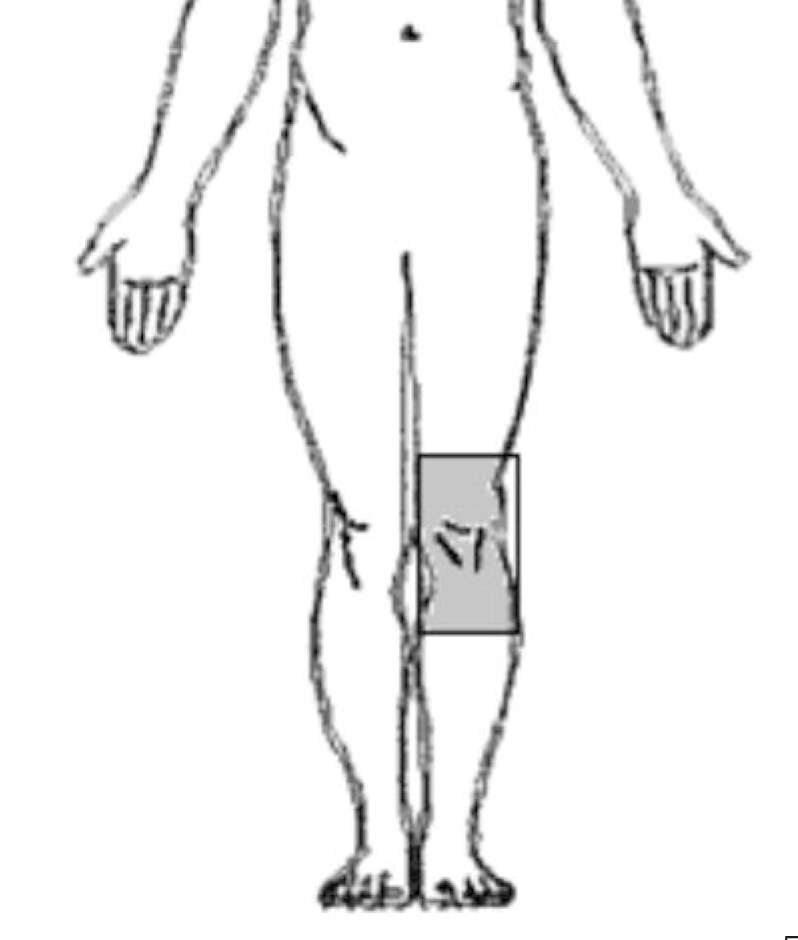Knee arthroscopy
Information on knee surgery
This patient information booklet will explain the preparations and examinations you require before your knee arthroscopy. We also hope to answer some of your questions about being admitted to the hospital, the operation and the recovery period.
In our experience, patients are spared many worries and surprises when they know what will happen in advance. Therefore, it is advisable to read this information carefully.
Keyhole knee surgery (arthroscopy)
Arthroscopy involves examining the knee using a thin arthroscope, and if the examination reveals damaged meniscus tissue or similar injuries, these can be removed or repaired simultaneously.

Arthroscopy of the knee joint can reveal damage and irritation of:
- Cartilage, i.e. the surface covering of the bones inside the knee
- Mucous membranes
- The internal and external meniscus
- Cruciate ligament
The specialist assesses whether it is possible to repair any damage during the actual arthroscopy examination.

Before the operation
To minimise the risk of infection, you cannot have surgery if you have any wounds, cuts, scrapes, scratches or ‘spots’ on or near the operation site, and you must not have major wounds elsewhere on your body. Infections (e.g., of the teeth or urinary tract) must be treated before the operation.
If you are otherwise healthy, i.e. in good nutritional condition, and if you limit smoking and alcohol consumption, you have the best chance of healing quickly.
Please take a shower on the morning of the operation - soap may be used - but no body lotion.
On the day of the operation, please shave any hair on your leg according to the instructions.
Guidance on shaving for the knee operation
For arthroscopy on the left/right leg, the following area of skin is shaved:
Shave about 15 cm above and below the knee, both on the front and back of the knee.
Shaving can only be done on the day of the operation and must be done with an electric razor or hair clippers.

Arrangements at home
Before the arthroscopy operation, it is important that you prepare to go home. You do this by:
- Creating space between furniture.
- Buying groceries for the weeks after being discharged.
- It’s a good idea to cook meals and freeze them.
- Make arrangements with family/friends or home care for help after being discharged.
På operationsdagen
You go to the hospital ward at the agreed time. Here you will be welcomed by a nurse who will show you where to go, make the necessary preparations before the operation and answer any questions you may have.
You will need to wear hospital clothing during the operation.
To protect the dressing after the operation, you should bring wide-legged trousers, such as jogging trousers, and flat shoes to wear when you go home.
Before the operation, the surgeon and anaesthetist will meet you, talk to you about the anaesthetic and answer any questions you may have.
Fasting
It is important that you fast before the anaesthetic. The fasting rules mean that you can eat solid food (including sweets) and drink milky liquids up to 6 hours before you arrive at the hospital. You can drink water, squash, juice, coffee, or tea without milk/cream up to 2 hours before arrival. We recommend drinking 1 glass of sweet squash or juice 2 hours before arrival.
Usual medicine
If you are taking blood thinners such as Marevan or Marcoumar, you should generally stop taking them 5 days before the operation. Agree with the surgeon on the next steps regarding blood tests and starting medication after the operation.
If you have diabetes, we will endeavour to operate early in the day. You should not take any insulin or tablets before the operation. However, you must bring your usual diabetes medication with you.
We will check your blood sugar levels on admission and after the operation.
All other medicines, including antihypertensive and heart-strengthening medicines, should be taken as usual.
Please bring your usual medication with you.
The operation
The operation lasts about 15-25 minutes. You will be under general anaesthesia throughout the procedure. At the end of the operation, a local anaesthetic is injected into the skin around the knee joint. The incision sites from the arthroscope and instruments are sutured with a few stitches, and a dressing is applied, which must be removed after 1 day.
Just after the operation
Immediately after the operation, you will be taken to the recovery room and ready to get dressed in about half an hour.
When you are ready, you will have a consultation with the surgeon who operated on you. The surgeon will explain what was found during the arthroscopy operation, what has been done and the expected recovery period. It is a good idea to have a relative/companion present during this conversation.
You are not allowed to drive, cycle or take the bus after the operation, and we recommend that you are accompanied home by an adult. The journey home can be done in an ordinary car with a driver, and it may be a good idea to sit in the back seat with your operated leg elevated for the journey home.
The day after the operation, you may remove the bandage and apply small plasters to the injection sites. After 2 days, the plasters may be removed once the wounds are dry and any oozing has stopped. At this point, water is allowed to get on the injection sites, i.e. you can take a shower without covering the injection sites.
It is recommended to have the stitches above the injection sites removed by your doctor 10-14 days after the operation.
The first weeks after the operation
When a damaged meniscus or other tissues in the knee are removed, a wound is left inside the knee. The wound needs time and rest to heal, just like any other wound.
Optimal healing is achieved by resting the knee for the first 2 weeks after the operation, which means staying at home, keeping your leg elevated and using an ice pack for the first few days after the operation. The ice treatment is a complement to the painkillers. The ice should not be placed directly on the skin, but preferably with a cloth between them.
For the first 2 weeks after the operation, it is recommended that you only walk around your home for the most essential purposes, i.e. going to the toilet and moving between the living room, bedroom and kitchen. The use of crutches is usually not necessary or beneficial during this period. You should try to walk as normally as possible, perhaps with slightly shorter strides and at a slower pace to avoid limping.
Panodil, which you buy yourself before the operation, can be used as a painkiller. Painkillers in the form of Ibumetin and Oxynorm are provided upon being discharged, along with oral and written instructions. However, the best pain-relief effect is achieved by relieving the pressure, lifting the leg high, and possibly an ice pack over the knee. It is not recommended to put a pillow under the knee.
In the first few weeks, the knee will usually be swollen, slightly warm and sore, which is normal and is a sign that the wound in the knee is healing. However, the knee may be swollen for much longer without indicating something is wrong.
If healing is fast, the knee is ready to increase the load with caution 2 weeks after the operation. If the knee is no longer sore and not swollen, you can start walking short distances of a few 100 metres outdoors. If the knee swells or becomes very sore afterwards, it is too early to increase the load further. So, for the next 2-4 weeks, experiment with walking further, but never more than to avoid further swelling of the knee.
You may drive yourself when you do so safely, in accordance with the Road Traffic Act. Usually after 2-4 weeks.
Sick leave
If recovery is rapid and you have a sedentary job, you can expect to be off work for between 2 and 6 weeks, taking into account your knee. If you have more physical work, such as heavy leg-straining work, you may need a longer period of sick leave.
Rehabilitation
Exercises are attached for the first 2-3 weeks after the operation. Often you will also be referred for further rehabilitation by a physiotherapist, which is agreed individually with the surgeon. Likewise, it is important that several times a day, you ensure that you can stretch the knee completely and bend the knee where it is natural, e.g., when dressing and the like. An inappropriate amount of exercise in the first 6 weeks after the operation can cause the wound inside the knee to heal slower, resulting in a longer recovery period.
You can return to normal everyday activities and sports if you can do them without problems or limping. If the knee is provoked to swell further, it is crucial to take a break before resuming the activity. The following are only indicative.
Exercise bike without resistance after 2-4 weeks as agreed with your doctor.
Swimming (crawl) after about 4 weeks.
Running can be started gently after 6 weeks, provided there are no problems.
Contact sports after 6-12 weeks, provided there are no problems with running.
Some soreness of the knee can be expected with heavy physical exertion up to about 12 months after the operation.
A few patients may have a very long recovery period, and the final result after the operation can only be expected to be achieved 1 year after surgery.
Outpatient checks
Post-operative checks are not normally agreed upon.
Complications
Inflammation
In very rare cases, inflammation of the knee can occur after the operation - less than 0.5 per thousand experience this. Redness and irritation may occur at the injection sites that are slightly more common, which is harmless and disappears after the stitches are removed.
Phlebitis
There is about a 1% risk of phlebitis, which can lead to a blood clot in the leg.
Nerve damage
Damage to the small nerves in the skin around the knee can occur in very rare cases, and this will not cause problems in the longer term.
Lack of effectiveness of the procedure
Patients with moderate or severe osteoarthritis of the knee may not benefit significantly from the procedure.
Contact us
You are always welcome to contact the staff if you have questions about your operation or the time afterwards.
Specialists and practitioners







